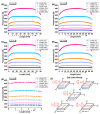Thermo-Mechanical and Thermo-Electric Properties of a Carbon-Based Epoxy Resin: An Experimental, Statistical, and Numerical Investigation
- PMID: 39063892
- PMCID: PMC11278644
- DOI: 10.3390/ma17143596
Thermo-Mechanical and Thermo-Electric Properties of a Carbon-Based Epoxy Resin: An Experimental, Statistical, and Numerical Investigation
Abstract
Due to their remarkable intrinsic physical properties, carbon nanotubes (CNTs) can enhance mechanical properties and confer electrical and thermal conductivity to polymers currently being investigated for use in advanced applications based on thermal management. An epoxy resin filled with varying concentrations of CNTs (up to 3 wt%) was produced and experimentally characterized. The electrical percolation curve identified the following two critical filler concentrations: 0.5 wt%, which is near the electrical percolation threshold (EPT) and suitable for exploring mechanical and piezoresistive properties, and 3 wt% for investigating thermo-electric properties due to the Joule effect with applied voltages ranging from 70 V to 200 V. Near the electrical percolation threshold (EPT), the CNT concentration in epoxy composites forms a sparse, sensitive network ideal for deformation sensing due to significant changes in electrical resistance under strain. Above the EPT, a denser CNT network enhances electrical and thermal conductivity, making it suitable for Joule heating applications. Numerical models were developed using multiphysics simulation software. Once the models have been validated with experimental data, as a perfect agreement is found between numerical and experimental results, a simulation study is performed to investigate additional physical properties of the composites. Furthermore, a statistical approach based on the design of experiments (DoE) was employed to examine the influence of certain thermal parameters on the final performance of the materials. The purpose of this research is to promote the use of contemporary statistical and computational techniques alongside experimental methods to enhance understanding of materials science. New materials can be identified through these integrated approaches, or existing ones can be more thoroughly examined.
Keywords: graphene nanoplatelets; multiphysics simulations; nanocomposites; structural epoxy resin; thermo-electric properties; thermo-mechanical properties.
Conflict of interest statement
The authors declare no conflicts of interest.
Figures


























References
-
- Bryan H. Engineering Composite Materials. 2nd ed. CRC Press; London, UK: 1999.
-
- Jeff K. Replacing metal with plastic. Mach. Des. 2016;88:34–42.
-
- Nicolais L., Meo M., Milella E. Composite Materials: A Vision for the Future. Springer Science & Business Media; London, UK: 2011.
-
- Mark J., Ngai K., Graessley W., Mandelkern L., Samulski E., Wignall G., Koenig J. Physical Properties of Polymers. Cambridge University Press; Cambridge, UK: 2004.
-
- Allaouia A., Baia S., Cheng H., Bai J. Mechanical and Electrical Properties of MWNT/Epoxy Composite. Compos. Sci. Technol. 2002;62:1993–1998. doi: 10.1016/S0266-3538(02)00129-X. - DOI
Grants and funding
LinkOut - more resources
Full Text Sources

